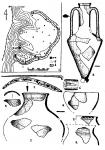Summary (English)
Lipliave hillfort is situated on the left bank of the Dnieper, on the edge of a high cape, covered by the forest. It has the form of a trapezoid with an area of 12 hectares. From the west, it is bordered by a steep slope. Three ravines cut into the hillfort’ area from this slope. From the other side, it is surrounded by the earthen rampart made from the sandy earth. The defensive earthworks were explored in the years 1996-2000. Two horizons with burnt wooden construction were traced under the southern part of the rampart. It was 2 m wide and made from oak beams. The thickness of the burned layer with remnants of the wooden walls is from 0.8 to 1 meter. However, no remnants of the wooden wall were traced on the other parts of the earthworks.
Several trial trenches were excavated at the SW part of the hillfort where burned wood was visible on the modern surface. The cultural layer near the walls was about 0.1 – 0.5 m thick while on most parts of the hillfort there were no cultural deposits at all. Also, the quantity of the artefacts discovered was quite low. Only about 50 fragments of pottery from several wares were found. Typical finds from the trenches are the cooking ware fragments with rims decorated with pricks. Also, parts of large storage jar were found here. Table ware is not typical for this site. Chronological markers are the 5th c. BC trilobe arrowhead and scattered 4th c. BC Chios amphora with the stamp “…ΤΟΥ” on the handle. Other interesting artefacts are an iron sickle and fragment of a small yellow glass vessel.
No open settlements were found near the hillfort. No dwellings were discovered at the site as well. Thus, the authors supposed that there was no permanent population on the hillfort and that it was erected as a refuge.
- Shelekhan Oleksandr - Institute of Archaeology, National Academy of Sciences of Ukraine
Director
- Rozdobudko Mykhailo Vitaliiovych - Pereyaslav National Historical and Ethnographic Reserve
Team
Research Body
- Pereyaslav National Historical and Ethnographic Reserve






![Download [PDF]](/excavation/skins/fasti/images/results/download_sml.png)